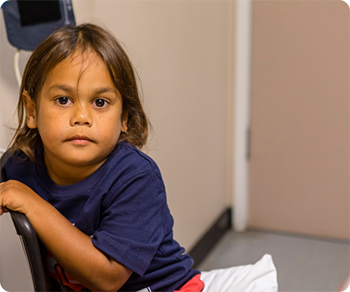The clinical tool can be used to track the effectiveness of treatment of respiratory infections in childhood, with the aim of reducing the likelihood of poor lung function and related disease in adulthood.
 Aboriginal and Torres Strait Islander peoples are 2.5 times more likely to develop a chronic respiratory condition compared to non-Aboriginal and Torres Strait Islander people.
Aboriginal and Torres Strait Islander peoples are 2.5 times more likely to develop a chronic respiratory condition compared to non-Aboriginal and Torres Strait Islander people.
As part of his PhD research with Queensland University of Technology respiratory scientist Andrew Collaro investigated how the lung function of Aboriginal and Torres Strait Islander peoples tracked over time to evaluate the benefit of paediatric respiratory outreach care.
“We chose lung function to evaluate the outreach service model, because establishing a ‘normal’ healthy lung function for a child helps us to best set them up for adulthood,” Mr Collaro said.
“If you have poor lung function in childhood, the overwhelming odds are that it will be poor in adulthood and that increases your risk of all sorts of things – respiratory disease, cardiovascular disease and all-cause mortality.”
The Children’s Health Queensland cough and airways research group, led by Professor Anne Chang, assessed the lung function of more than 1,400 healthy Aboriginal and Torres Strait Islander children and adults over an eight-year period.
The team also partnered with the Telethon Kids Institute in Western Australia to recruit children and adults living in the Kimberley and in Perth.
Participants, ranging in age from three to 91 years, underwent a fractional exhaled nitric oxide test (asthma screening) and spirometry testing to establish reference values.
“Previous reference values for First Nations people didn’t exclude behavioural and physical outliers such as smoking and obesity,” Mr Collaro said.
“This was the first study to recruit participants outside of respiratory clinics – we wanted to include healthy lungs as well.
Fractional exhaled nitric oxide reference values were published in Chest in October 2022, with the reference values for spirometry forthcoming.
In addition, Mr Collaro looked at the effect early childhood respiratory infection had on lung function in childhood and then in adulthood, in the first systematic review of its kind.
“In the first five years of life, there’s a lot of growth happening both in the airways and in your lungs and because there’s a lot of growth happening, the theory was always that you’re extra susceptible to infections.”
Andrew Collaro “So if you have an infection in early childhood when all this growth and development is happening, does that affect you later in life, is there lasting damage? The answer is yes.”
Mr Collaro said more evidence was needed from non-Western countries to understand the true impact of lower respiratory infections on lung development.
“This review uncovered that the data available on lung function after early childhood infection is from affluent European countries and countries in North America where the problem is not as significant,” he said.
“We don’t actually know much about what’s going on in those areas where early childhood infection is at its worst.”
The study also recommended the creation of age- and height adjusted reference values be considered for other ethnicities.